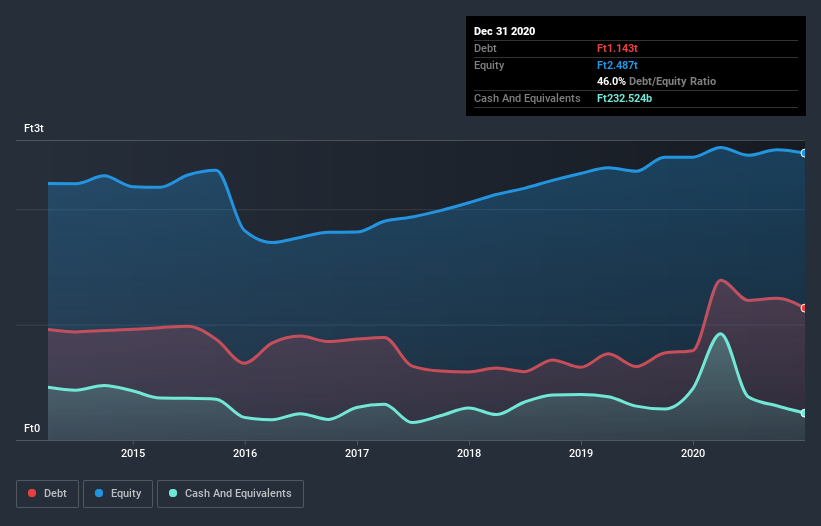- Hungary
- /
- Oil and Gas
- /
- BUSE:MOL
MOL Magyar Olaj- és Gázipari Nyilvánosan Muködo Részvénytársaság (BUSE:MOL) Seems To Be Using A Lot Of Debt

Howard Marks put it nicely when he said that, rather than worrying about share price volatility, 'The possibility of permanent loss is the risk I worry about... and every practical investor I know worries about.' So it seems the smart money knows that debt - which is usually involved in bankruptcies - is a very important factor, when you assess how risky a company is. Importantly, MOL Magyar Olaj- és Gázipari Nyilvánosan Muködo Részvénytársaság (BUSE:MOL) does carry debt. But is this debt a concern to shareholders?
When Is Debt A Problem?
Debt assists a business until the business has trouble paying it off, either with new capital or with free cash flow. Part and parcel of capitalism is the process of 'creative destruction' where failed businesses are mercilessly liquidated by their bankers. However, a more usual (but still expensive) situation is where a company must dilute shareholders at a cheap share price simply to get debt under control. Of course, debt can be an important tool in businesses, particularly capital heavy businesses. The first thing to do when considering how much debt a business uses is to look at its cash and debt together.
See our latest analysis for MOL Magyar Olaj- és Gázipari Nyilvánosan Muködo Részvénytársaság
What Is MOL Magyar Olaj- és Gázipari Nyilvánosan Muködo Részvénytársaság's Net Debt?
You can click the graphic below for the historical numbers, but it shows that as of December 2020 MOL Magyar Olaj- és Gázipari Nyilvánosan Muködo Részvénytársaság had Ft996.5b of debt, an increase on Ft773.9b, over one year. However, it also had Ft232.5b in cash, and so its net debt is Ft763.9b.

How Healthy Is MOL Magyar Olaj- és Gázipari Nyilvánosan Muködo Részvénytársaság's Balance Sheet?
According to the last reported balance sheet, MOL Magyar Olaj- és Gázipari Nyilvánosan Muködo Részvénytársaság had liabilities of Ft1.38t due within 12 months, and liabilities of Ft1.65t due beyond 12 months. Offsetting this, it had Ft232.5b in cash and Ft536.5b in receivables that were due within 12 months. So its liabilities outweigh the sum of its cash and (near-term) receivables by Ft2.25t.
This deficit casts a shadow over the Ft1.37t company, like a colossus towering over mere mortals. So we'd watch its balance sheet closely, without a doubt. At the end of the day, MOL Magyar Olaj- és Gázipari Nyilvánosan Muködo Részvénytársaság would probably need a major re-capitalization if its creditors were to demand repayment.
In order to size up a company's debt relative to its earnings, we calculate its net debt divided by its earnings before interest, tax, depreciation, and amortization (EBITDA) and its earnings before interest and tax (EBIT) divided by its interest expense (its interest cover). This way, we consider both the absolute quantum of the debt, as well as the interest rates paid on it.
MOL Magyar Olaj- és Gázipari Nyilvánosan Muködo Részvénytársaság has a very low debt to EBITDA ratio of 1.3 so it is strange to see weak interest coverage, with last year's EBIT being only 0.61 times the interest expense. So while we're not necessarily alarmed we think that its debt is far from trivial. Shareholders should be aware that MOL Magyar Olaj- és Gázipari Nyilvánosan Muködo Részvénytársaság's EBIT was down 77% last year. If that earnings trend continues then paying off its debt will be about as easy as herding cats on to a roller coaster. The balance sheet is clearly the area to focus on when you are analysing debt. But ultimately the future profitability of the business will decide if MOL Magyar Olaj- és Gázipari Nyilvánosan Muködo Részvénytársaság can strengthen its balance sheet over time. So if you want to see what the professionals think, you might find this free report on analyst profit forecasts to be interesting.
Finally, a company can only pay off debt with cold hard cash, not accounting profits. So it's worth checking how much of that EBIT is backed by free cash flow. During the last three years, MOL Magyar Olaj- és Gázipari Nyilvánosan Muködo Részvénytársaság produced sturdy free cash flow equating to 62% of its EBIT, about what we'd expect. This cold hard cash means it can reduce its debt when it wants to.
Our View
To be frank both MOL Magyar Olaj- és Gázipari Nyilvánosan Muködo Részvénytársaság's EBIT growth rate and its track record of staying on top of its total liabilities make us rather uncomfortable with its debt levels. But at least it's pretty decent at converting EBIT to free cash flow; that's encouraging. Overall, it seems to us that MOL Magyar Olaj- és Gázipari Nyilvánosan Muködo Részvénytársaság's balance sheet is really quite a risk to the business. For this reason we're pretty cautious about the stock, and we think shareholders should keep a close eye on its liquidity. There's no doubt that we learn most about debt from the balance sheet. However, not all investment risk resides within the balance sheet - far from it. For instance, we've identified 1 warning sign for MOL Magyar Olaj- és Gázipari Nyilvánosan Muködo Részvénytársaság that you should be aware of.
Of course, if you're the type of investor who prefers buying stocks without the burden of debt, then don't hesitate to discover our exclusive list of net cash growth stocks, today.
When trading MOL Magyar Olaj- és Gázipari Nyilvánosan Muködo Részvénytársaság or any other investment, use the platform considered by many to be the Professional's Gateway to the Worlds Market, Interactive Brokers. You get the lowest-cost* trading on stocks, options, futures, forex, bonds and funds worldwide from a single integrated account. Promoted
New: Manage All Your Stock Portfolios in One Place
We've created the ultimate portfolio companion for stock investors, and it's free.
• Connect an unlimited number of Portfolios and see your total in one currency
• Be alerted to new Warning Signs or Risks via email or mobile
• Track the Fair Value of your stocks
This article by Simply Wall St is general in nature. It does not constitute a recommendation to buy or sell any stock, and does not take account of your objectives, or your financial situation. We aim to bring you long-term focused analysis driven by fundamental data. Note that our analysis may not factor in the latest price-sensitive company announcements or qualitative material. Simply Wall St has no position in any stocks mentioned.
*Interactive Brokers Rated Lowest Cost Broker by StockBrokers.com Annual Online Review 2020
Have feedback on this article? Concerned about the content? Get in touch with us directly. Alternatively, email editorial-team (at) simplywallst.com.
About BUSE:MOL
MOL Magyar Olaj- és Gázipari Nyilvánosan Muködo Részvénytársaság
Operates as an integrated oil and gas company in Hungary and internationally.
Flawless balance sheet, undervalued and pays a dividend.

